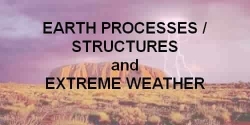Mud Volcanoes
Mud Volcanoes
Mud Volcanoe Basics
Elements likely needed to create a mud volcanoe...
Cold Mud Volcanoes
Hot Mud Volcanoes
Some current theories on mud volcanoes include...
Mud Volcanoes in Australia - Apsley Mud Mounds
Sources
see also Volcanoes /
Volcanic Hazards...
Mud Volcanoe Basics
Mud volcanoes aren’t like typical volcanoes that spew molten lava from the mantle.
For one thing they are generally cold.
If classic volcanoes vomit the earth’s churning guts, then mud volcanoes are more like a burp.
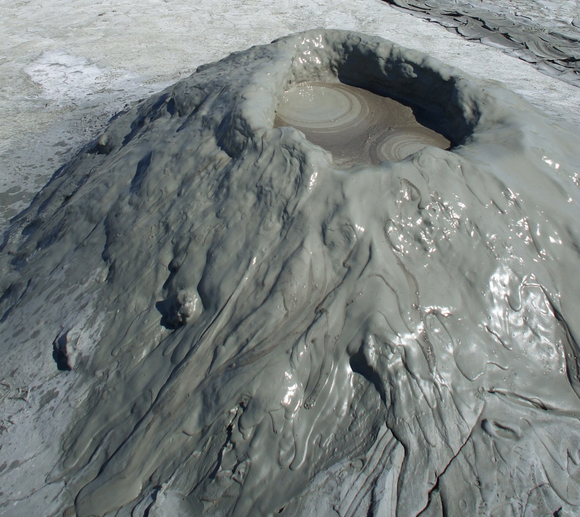
There are about 1,100 mud volcanoes that have been identified around the world, and nearly 400 of them can be found in and around the hydrocarbon bearing strata of Azerbaijan.
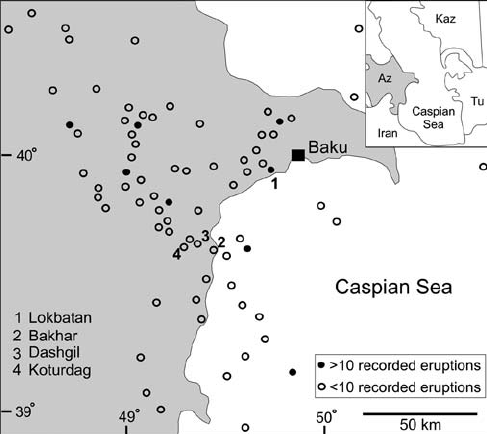
They form when fluids and gases that have built up under pressure inside the Earth find an escape route to the surface via a network of fractures.
The fluids move up these cracks, carrying mud with them, creating the mud volcanoe as they escape.
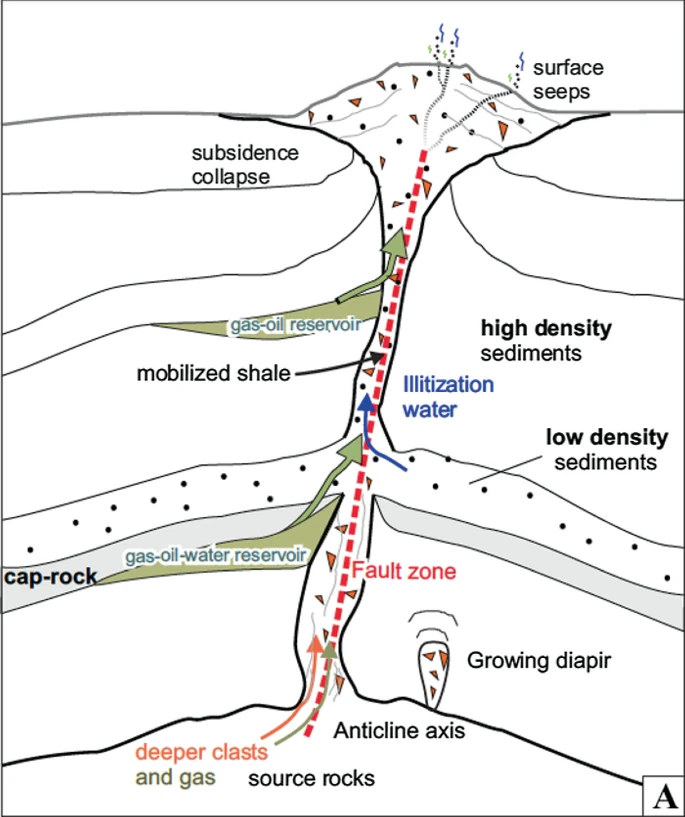
Gryphons are small mud cones up to a few meters high, can be numerous, and often are aligned with tectonic structures.
The erupted materials are three-phase: solids, water, and gases, the latter being dominantly methane CH4 and carbon dioxide CO2.
Elements likely needed to create a mud volcanoe...
- rapid accumulation of great thicknesses of unconsolidated sediments
- a fairly uniform fine particle size, often shale size
- high water content
- pressurised high methane CH4 carbon dioxide CO2 content
- often an impermeable cap rock or unconsolidated material (like shale or clay)
- a souce of increasing pressure either by overlying strata, tectonic movement or heat via volcanism
- a restricted escape route to the surface
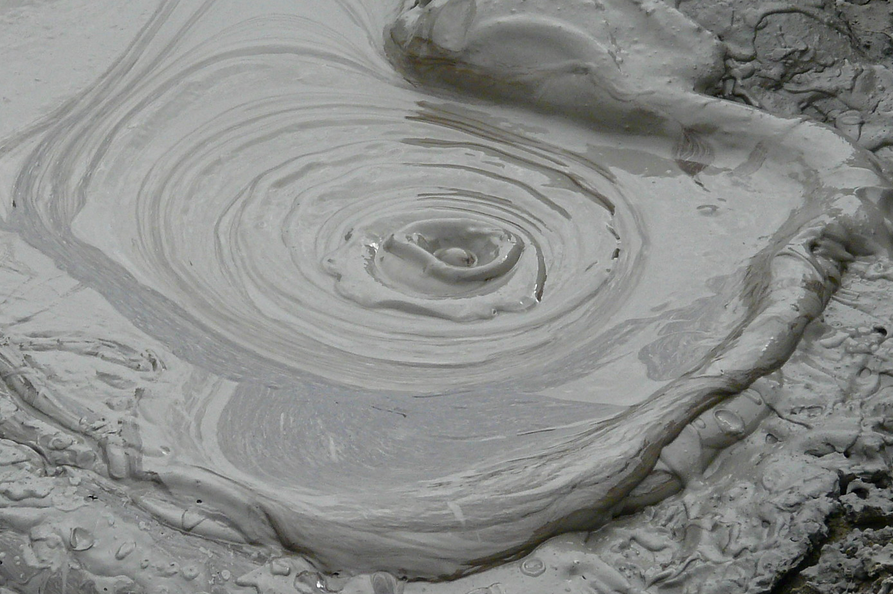
Cold Mud Volcanoes
Mud volcanoes are often associated with petroleum deposits and tectonic subduction zones and orogenic belts; hydrocabon methane gas is erupted. Reduced pressure causes to be entrapped gases to expand. Lower density causes the saturated unconsolidated muddy/silty sediment to liquify.
When an escape route for the wet pressurised mud activates, the reduced pressure on the entrapped methane or carbon dioxide CO2 causes it to change from liquid to gaseous state.
To do this heat is extracted from the surrounding mud. This makes the mud cooler.
Hot Mud Volcanoes
They are also associated with lava volcanoes; in the case tectonic heat causes the water and entrapped gas usually H2 or CO2 to expand. The result is a mud slurry exudate. This material is then forced upwards by the pressure of its own expansion. through a local geological fault or fissure.
Overpressure within the Earth builds up when underground fluids are unable to escape from beneath the weight of overlying sediments. Some of this fluid was trapped within the sediment when it was deposited. Other fluids may migrate in from deeper sediments, while still others may be generated in place by chemical reactions in the sediments. One important type of chemical reaction generates oil and natural gas. Finally, fluids may become overpressured if they are squeezed by tectonic forces during mountain building. Mud volcanoes are also useful to scientists as windows into conditions deep inside the Earth.
Some current theories on mud volcanoes include...
- bodies of remobilised shale are called shale diapirs and are thought to be formed by growing upwards from depth due to buoyancy or
- by high sediment accumulation rates and inefficient expulsion of water or
- because of insuffiant accommodational pore spaces that are principally due to tectonic compressions or shale diapirsm can also occur due to differential loading or
- sedimentary basins, pore water can locally become supercritical which drives the expulsion of gas, liquid, mud and clasts to the surface where each expulsion of mud to the earth surface is interpreted as an act of pressure equilibratation between the mud chamber and surface
The exact mechanisms for the formation of mobile shale mud is still not well known.
Mud volcanism on other planets (e.g. Mars and Titan), and microbial activity associated with gas seepage represent emerging issues and opportunities for future research.
Mud Volcanoes in Australia - Apsley Mud Mounds
The mud springs are a unique geological feature, being possibly one of
only two such formations in Australia. Location: 2 Hawbridge Street, Carseldine, Queensland 4034.
From 1865, the mud springs were part of a farm. In 1970, Brisbane City Council works disturbed the site resulting in an eruption of hot mud and stinking hydrogen sulphide gas H2S. A concrete cap was placed over the mud springs to stop the flow and the site fenced for public safety. In 1979, the site became a park.
This property contains a rare geological formation, hot mud springs, of which there is possibly only one other similar site in Australia. The mud springs have a subterranean depth of 30 metres and comprise a dome of methane gas under a clay cap.
They are connected by an underground stream to a sub artesian basin that runs as far as Bald Hills. Originally the mud springs had two outlets, with one at the present location of this park and the other being further east near what is the section of Gympie Road that is north of Cabbage Tree Creek.
The area containing these two mud springs would have been known to the Undanbi people and may have had some spiritual significance for them.
Because of its unique geological activity, the mud mounds site was selected in 1970 for a test bore to be drilled in the search for natural gas.
The bore was sunk to a depth of 360 metres and testing gave indications that there were substantial reserves of methane gas underground to a depth of 1,300 metres.
Also in 1970, the Brisbane City Council began laying a large water main across Graham Road, to service the planned residential redevelopment of farmland in the area.
In the process, the Council demolished the mud mounds and this led to a large amount of hot mud pouring out of the resultant hole in the ground. It moved in two streams “like a giant toothpaste tube” across Hawbridge Street thereby blocking access.
As well, hydrogen sulphide gas began to escape into the atmosphere causing a terrible stench to permeate the surrounding area. Hawbridge Street had to be closed for eight weeks, as Council trucks removed the mud from the site, causing the ground to sink.
In the end, the Council resorted to dumping sheet pilings onto the mud to form a caisson for its water pipes plus twelve truckloads of cement were poured over the pipes to secure them in place.
At the completion of this work, the earth crust covering the mud springs was only 15 centimetres thick. So, as a safety precaution, the mud springs site was enclosed by a high fence, with warning signs erected, advising the public to keep off the area
Sources
https://www.sciencedirect.com/science/article/abs/pii/S0012825216302197
https://theconversation.com/what-are-mud-volcanoes-173198
https://www.smithsonianmag.com/smart-news/azerbaijan-mud-volcano-erupts-fiery-fashion-180978120/
https://www.accuweather.com/en/weather-news/mud-volcano-produces-explosion-near-azerbaijan-in-caspian-sea/975009
https://stopandstay-7wonders.blogspot.com/2011/04/mud-volcano.html
https://www.fluid-venting-system.org/mud-volcano-taiwan-island.html
https://link.springer.com/chapter/10.1007/978-3-030-64308-9_12
https://www.searchanddiscovery.com/pdfz/documents/2017/70261gulmammadov/ndx_gulmammadov.pdf.html
Mud Volcano cross-section image from... Mazzini A, Etiope G (2017) Mud volcanism: an updated review. Earth Sci Rev 168:81–112
https://www.researchgate.net/profile/Sverre-Planke/publication/226567150/figure/fig1/AS:302241463455745@1449071388253/The-distributions-of-active-mud-volcanoes-in-Azerbaijan-Az-The-numbered-mud.png
brisbane-mud-springs-park_480.pdf

